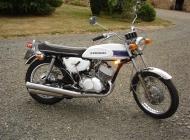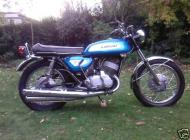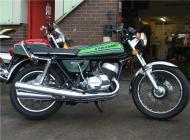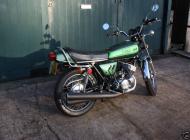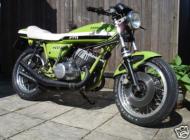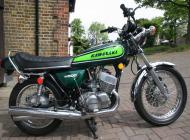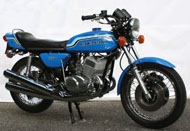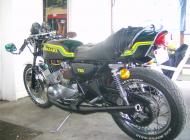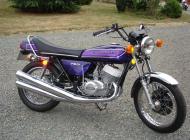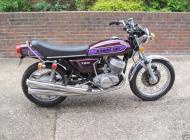Unfortunately, Mick Presland called back — and back and back until I
found myself warily eyeing an admittedly immaculate looking Mach III in a
pub car park near Letchworth. It was an unseasonally bright, dry day., .but
if everything they said was true then I'd, er: 'Let's go in and have a pint
while you tell me about it, Mick.'
Seems Mick, 23, had had a hankering for an early Kawa triple for quite
some time. A pretty weird ambition for someone who'd had to sell a CS1000
because it wouldn't handle properly under his light weight. Now he's got a
Rickman framed Z1 for day-to-day work and play.
Mick was looking for a lazy restoration project as much as a second
string roadburner to complement the Z1, hence the two years it's taken him
to get the H1 on the road. 'I was really looking for an early H2 750 but
the H1 turned up first at a dealer
in Essex so I bought it instead. It looked quite clean until I got close.
Then it looked pretty bad, though I suppose it wasn't that dreadful seeing
as the previous owner used it as an everyday bike.'
Luckily the triple was mechanically sound and in almost original
condition bar a crude home made air scoop and a bit of al fresco drilling
on the front brake, apparently aimed at preventing overheating. Mick wasn't
sure about the paint scheme — off-white with a red panel on the tank but
seeing as neither Kawasaki UK nor former importers Agrati Ltd could help
him with details, he wrote to Kawasaki in Japan.
Two months later he received a couple of fuzzy photos and a few details:
enough to tell him the original colours were Midnight White and Peacock
Grey (powder blue really), so tank, side panels and oil tank went off to
Dream Machine for a convincing respray. The Mach III badge on the sidepanel
was obtained through an advert in MCN but the electronic ignition
flash on the oil tank is a bit of restorer's licence. The first His did
use CDI ignition and pretty hot zits that was back in 1969 but UK versions
had conventional points (lucky, because the CDI version proved so
troublesome that Big K eventually dropped it for a while in 1971 before
going over to the improved H2 type in '72). Well, the logo looks smart and
it takes Mick's mind off the exacting job of setting up the carbs and
ignition timing.
Aside from a basic top-end overhaul, Mick hasn't done anything to the
motor. The bottom end's a pretty tough piece of work anyway, with the 120°
crank running in no less than six main bearings. He had* the wheels rebuilt
and renewed all cables, including the one operating the rear brake, and
scored a new set of pipes and front brake assembly from the Cradley Heath
emporium which supplied the bike. All that remained was to entice some
ail-too suspecting hack up to north Hertfordshire for a bout of fear and
loathing in the lanes.
Two things stood out about his finished Mach III. First it looked as if
it'd just come out of a crate; secondly, the first production models bear
only a passing resemblance to the beautifully swoopy, sleek lines of the
restyled 1973 H1D and its successors.
The narrow, slab-sided tank with shallow knee cut-outs looks reminiscent
ot a Triumph Trident's, the impression being reinforced by the Triumph-type
'bars on Mick's H1 which probably aren't original. The forks are original
though, as is the friction damper on the steering head, but the hydraulic
damper is a graft from a later model.
Not to put too fine a point on it, the H1's an odd looker. A 19in wheel
and long forks at the front, combined with an 18in rear wheel and short
shox, give the bike a mean, raked-back look despite its moderate 55in
wheelbase. All the weight is carried low and far back with a massive
overhang on the right of the motor where the points and Injectolube (now
there's a quaint term) oil pump live under a large silver-grey casing. All
in all it's not a recipe for ideal handling, especially when combined with
a short, small diameter tubular swing arm and an upright riding position
dictated by the wide bars and forward-mounted rider's pegs.
Back in '69, Kawasaki's marketing men rather hoped buyers would overlook
all this once the performance of 'probably the most explosive motorcycle
ever built' became established in riding legend. Much was made of the
motor's pedigree: designed by Kawasaki's aeronautical engineers, the blurb
ran. A real, uh, flyer.
Riding the thing had become somewhat unavoidable at this stage so I held
the handlebar-mounted, spring loaded choke lever forward and prodded the
kick lever a couple of times. The motor caught quickly and idled with a
surprisingly gentle burble and vast clouds of blue haze from the three
mufflers. The gearchange is a five-speed item with neutral at the bottom of
the five-up pattern. Pulling out of the car park, the Mach III proved to
possess rather more bottom end power than its all-or-bugger-all reputation
would lead most to expect.
Spotting Mick anxiously standing by an upcoming righthander, I
self-consciously changed up into second before opening up — well, s'not my
bike after all. The exhaust note remains deep and quite musical through the
rev range; nothing like the manic rattling banging and screaming of smaller
Kawa triples like the KH250. Six grand . . . any moment now . . . eyeballs
pressed into sockets . . . brain swirl . . . arms wrenched . . . world
going backwards. Seven grand . . . oh, so that's it.
The power step when the motor got on to its pipes was there all right
but it wasn't the blitzing transformation from docility to naked aggression
I'd somehow come to expect. From merely trundling along at a gently
increasing speed, the Mach III suddenly started really accelerating
noticeably.
If I'd hit the throttle as hard in second on Yamaha's YPVS 350LC, which
is said to make as much power as an H1, I'd have been fighting to keep the
front wheel down. Of course, the modern Yamaha is getting on for 1001b
lighter than the old Kawasaki so the difference isn't really so astounding.
You have to cast
your mind back to biking as it was in the late '60s (no, I can't either)
to appreciate the impression made by what was, for those days, an extremely
pipey powerplant.
Unfortunately, the only bug Mick hasn't been able to squash is a
slip-prone clutch. He thought he'd got it sorted but it wasn't long before
it started losing its grip when the powerband was reached while
accelerating hard. Shame, because once I'd recovered from the first taste
of the Mach Ill's lack of cornering prowess I wanted to cane it — which
means using all the gears and lots of revs for, true to form, this H1
wouldn't accelerate in top from less than 70mph.
Approaching the bumpy, varying radius bend where the pics were shot was
nerve wracking at first. If Everything They Said Was True the Mach III
might well break into a series of frenzied leaps and bounds without warning.
In fact, in spite of the poorly braced frame and antiquated suspension, it
coped very well apart from a pronounced desire to carry on in a straight
line.
Heartened, I went through the other way at a more progressive pace but
was confounded at the apex by an ominous scrape as the centrestand grounded
early. Big K made the cornering clearance somewhat smarter later on.
versions.
So long as one took care not to hit the powerband until well out of a
bend, the Mach III wasn't too much of a handful: find a sudden dose of
extra horsepower, though, and it'd try to pick itself up and carry straight
on. Much the same thing applied to rolling off power in a corner —
especially those on the crests of hills. This is a big H1 DO NOT 'cos it
provokes double-treble 'I'm going straight on and nothing can stop me'
behaviour.
Maybe this tendency would've been lessened without the effect of two
steering dampers but, in view of the lightness of the front end, that
alternative was too horrible to contemplate.
Shucks, at least half the legend's true. Mick's pride and joy was shod
with Contis front and rear, each a size up from the original 3.25 x 19in
and 4.00 x 18 Japlops and they at least presented no worries. The rebuilt
front brake wasn't bedded in, though, and the 7in sis rear drum was no
great shakes either, dinky chromed airscoop with adjustable vent an' all.
Compare the Mach III with the Uni-Track GPz750 also in this ish and you
can see just how far Jap motorcycles have progressed in the last 14 years.
In its time the triple was one hell of a radical scoot what with CDI
ignition, bare arsed performance, and the rest left to buyers' guardian
angels.
Riding both bikes really underlines the difference. The CPz is smooth,
fast, comfortable: it looks and feels poised and aggressive. The H1 is
harder, far more basic and strikingly clumsy in appearance by contrast — 90
per cent of the designers' effort went into its motor and it was four whole
years before a serious attempt was made to improve all the deficiencies in
handling, braking and styling. They never did manage to do anything
about its appalling thirst which rarely delivered more than 30mpg, meaning
fuel stops every 60 or 70 miles no thanks to a mean 3.3gal (15 litre)
fueltank.
It's doubtful whether any Mach Ills ever came close to the 125mph top
whack and low 12sec standing quarter times often rumoured: about 110 per
and c. 13.5 sees is more likely. Even so, there weren't a lot of 500s
around in 1969 which'd better the Kawasaki's sprint figures.
After more than a decade, the Mach Ill's reputation has definitely
outgrown the motorcycle. Still, it's essentially the right image and it
didn't succeed in putting off many riders who wanted the hairiest
stroker of the early 'seventies. They didn't buy His in spite of their
reputation anyway — they bought them because of it.







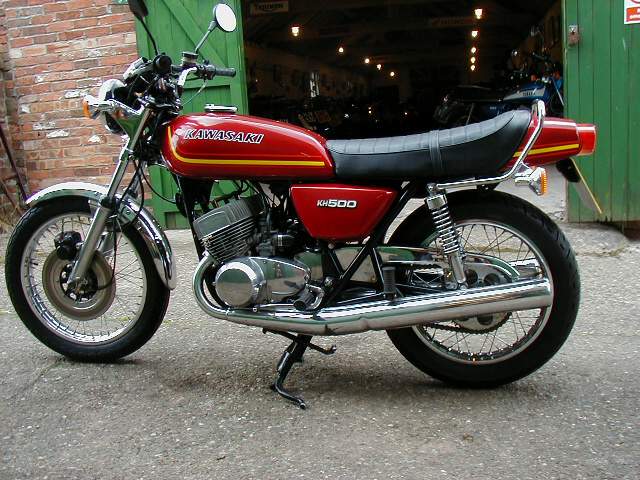

 Машина Mach III была действительно резвой и быстрой для класса 500 см3, ее
заявленная максимальная скорость приближалась к 193 км/ч, при этом 400 м с
места она преодолевала менее, чем за 13 секунд. Такая приемистость вместе с
короткой колесной базой способствовала тому, что при отрыве от светофора
трудно было избежать подъема машины на заднее колесо и задымления задней
покрышки.
Машина Mach III была действительно резвой и быстрой для класса 500 см3, ее
заявленная максимальная скорость приближалась к 193 км/ч, при этом 400 м с
места она преодолевала менее, чем за 13 секунд. Такая приемистость вместе с
короткой колесной базой способствовала тому, что при отрыве от светофора
трудно было избежать подъема машины на заднее колесо и задымления задней
покрышки.


